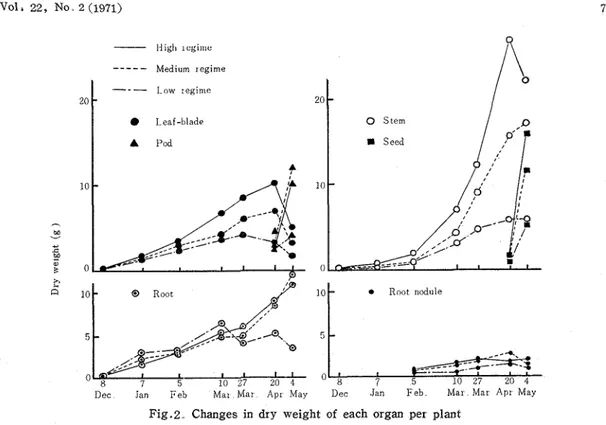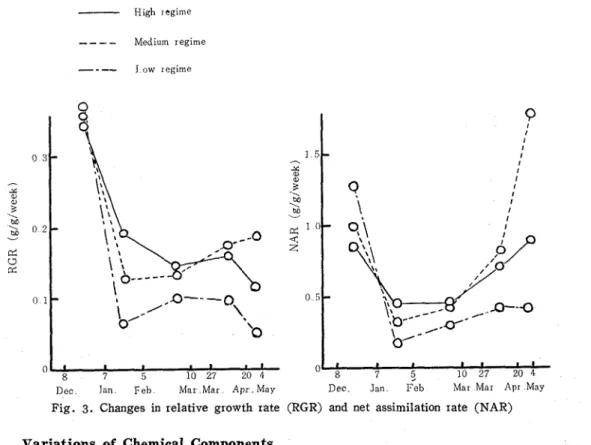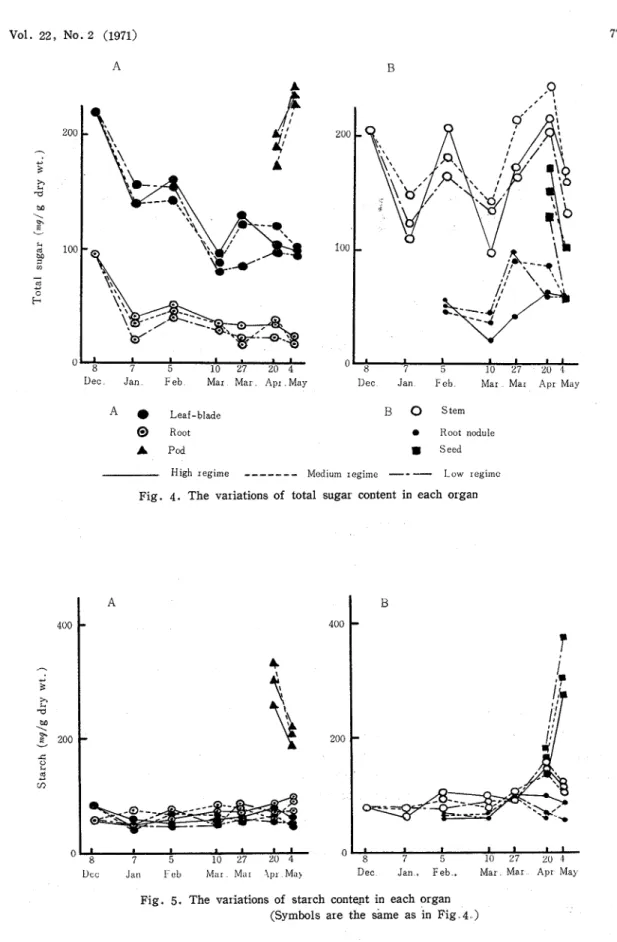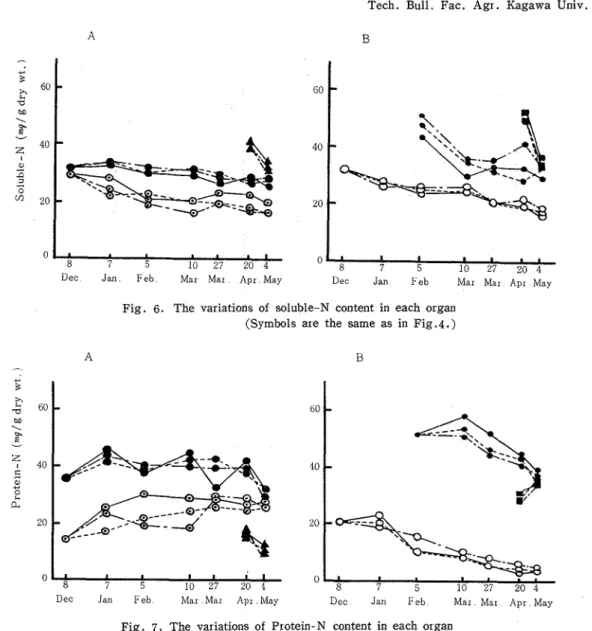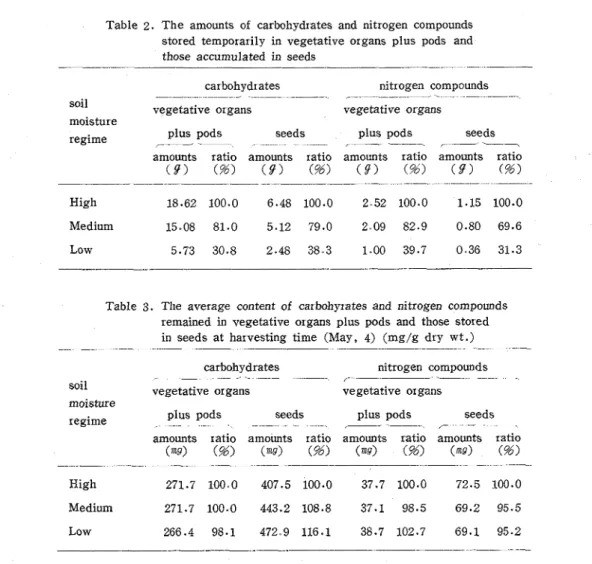PHYSIOLOGICAL STUDIES O F T H E GROWING PROCESS
OF BROAD BEAN PLANTS
JJI
Effects of Soil Moisture on the Growth and the Variations of Chemical Components in the Various OrgansKiyoshi TAMAKI and Junzaburo NAKA
The broad bean(Vzcza faba)is the popular pulse crop in the warmer region of Japan, as the second crop for paddy field or the wintsr crop for upland field, because this crop adapts to wide range of soil moisture and winter hardiness.
The water relationship of this crop have been investigated in detail for a long time. FUKUI et a1.(4), reporting on the differences of the adaptability for soil moisture on the growth of green manure and forage crops for paddy field, found that the growth and the fresh weight of the broad bean plant increased with increasing soil moisture. JONES'') also stated that for growth and seed yield, broad beans were remarkably tolerant of water, and that drought in the early stage of growth was more likely to be the greater hazard in practice. There are many observations which indicate that the flowering and the pod- setting are markedly influenced by decreasing soil moisture and that plant in the flower- ing period is more sensitive to drought than in the vegetative p e r i ~ d ( ' , ~ . ~ J ' ) . Moreover,
A I H A R A ' ~ ) also suggested that1seed production was depressed in wet soil moisture condi- tion, especially over 30 weight percentage, as well as in the condition for moisture stress. Although the number of related reports is increasing, there has been a lack of exper
-
imental work on the metabolic status or biochemical effects of broad bean plants encountered various soil moisture conditions. Theref ore, the present investigation was undertaken to obtain some informations concerning the effects of soil moisture on the growth and the variations of carbohydrate and nitrogen contents in the various organs of plants. In the experiment, three soil moisture regimes were imposed on plants.
Materials and Methods
Experiments were conducted in non--heated glass house. Broad beans, cultivar "Sanukinagasaya" were grown in pots of 30-cm-diameter filled with soil. On November 4, the materials were sown at nursery bed, and on November 30, the seedlings were transplanted, two plants per pot. One week after transplanting, all the pots were divided into 3 groups and named "High soil moisture regime, Medium, and Low". In each regime, soil moisture were maintained about 85 per cent, 65 per cent, and 35 per cent throughout the growing period, respectively, expressed as percentage of field capacity. Field capacity of used soil was 31.6 per cent. Each pot received 1.7 g ammonium sulfate,
74 Tech. Bull. Fac. Agr . Kagawa Univ.
At appropriate harvesting time, the sample plants were washed out. After the deter mination of plant height and growth items, plants were segregated into (a) leaf-blade,
(b) stem plus petiole, (c) root, (d) root nodule, (e) pod, and (f) seed, and weighed. The materials of various organ were dried in a n oven at 70" C, then were ground finely in a Willey mill.
The analyses were made for carbohydrates and nitrogen compounds. As for carbo- hydrates, sample was extracted by water at room temperature, soluble (total sugar) and insoluble (starch) portions hydro1 yzed by2HC1 were determined by the Somogyi method. For nitrogen compounds analysis, sample was extracted by trichloroacetic acid, soluble (soluble-N) and insoluble (pr otein-N) portion were deter mined by the micro-K jeldahl method.
Results Growing Process
Growing status of plants in three soil moisture regimes are shown in Figs 1 and 2 . In winter, the top growth was not remarkable. As for the stem length and leaf number per one stem, there were little differences among three regimes, while stem number increased in winter and became more in the order, high, medium, low regjme. On the other hand, the root growth was considerably vigorous and the dry matter production was greater in low regime and lower in high and medium regimes. In spring, the vege-
tative and reproductive growth
0----0 LOW rcgime 75 marched vigorously with the rise of
~ ~ greglme h temperature.
The high soil moisture condition produced taller and leafy plants. The low regime had the shorter plants, while
50 the medium regime was intermediate.
.c
With regard to the total stem length, total leaf number, and dry matter
a
production of stems and leaf-blades,s
theref ore, consider able discrepancies25 were noted in the figures. However,
dry matter production of roots was the least in low regime, and dry weight of root between high and medium regimes did not differ. 0
Dec Jan Feb M a r M a r Apr May
Fig.1,. Changes in total stem length and total leaf number per plant
---
Medium regime ILow regime 20-
Leaf-blade A Pod f 20-
0 Stem 0 Seed 10-
2"
10 -L 8 10 27 20 4 8 7 5Dec Jan Feb Mat Mar Apr May Dec .Jan Feb Mar Mar Apr May
Fig.2 Changes in dry weight of each organ per plant
Effects on earliness of flower opening were not recognized among three regimes. Though flowering lasted long period in high soil moisture regime, those later flower shed. Subsequently, the reproductive growth seemed to progress simultaneously in three regimes. Pod elongation and seed development, however, were affected by soil moisture conditions. Pod bearing stem number, pod length, pod number, seed number (Table I), and dry weight of pod and seed per plant (Fig. 2) were considerably higher in high and medium soil moisture regime than those in low regime.
Table 1. Effects of three soil moistme regimes on plant growth a t last harvesting time (May, 4) soil moisture
regime
pod bearing stem number*
pod length t
(cm) pod number* seed number
*
High 4.0 1 1 , 8 8.3 21.8
Medium 3.7 11.3 7.5 24.5
Low 3 . 3 10.2 3.0 9.0
*per plant t per pod
The behavior of relative growth rate (RGR) and net assimilation rate (NAR), expressed in g/g/week, were shown in Fig.3. General tendency was that both items showed high value in very early stage followed rapid drop in mid-winter, then RGR increased in the flowering stage and again declined in maturing stage, but NAR increased throughout the flowering-maturing stage. The different responses to soil moisture were
76 Tech. Bull. Fac., Agr
.
Kagawa Univ.recognized in mid-winter and in flowering-maturing stage ; in the former stage, RGR
and NAR were lower in the order, low, medium, high soil moisture regime, but in the latter stage, those were the highest in medium regime, low regime had a lowest value, and high regime was intermediate.
---
High regime--
-.-
Medium regime--
--
I ow regimeDec Jan F e h Mar Mar Apr May
,
I # I I I I
7 f, 10 27 20 4
Dec Jan F e b Ma1 Mar Apr May
Fig. 3. Changes in relative growth rate (RGR) and net assimilation rate (NAR) Variations of Chemical Components
The variations of carbohydrate content per gram of dry weight are shown in Figs 4 and 5. Total sugar in leaf-blades, stems, roots, and root nodules was high in the stages of very early, mid-winter
,
and flowering-maturing, respectively. The data indicated that, as a response of soil moisture regime, there was little effect on the sugar content of vegetative organs. However, more fluctuation in stems of high soil moisture regime through the growing period, and lower levels in leaf-blades and seeds of low regime in later stage, were noteworthy. As for the starch, though the contents in stems, root nodules and pods became high in later stage, evident differences in vegetative organs could not be detected among three soil moisture regimes.The variations of soluble-N and protein-N content per gram of dry weight in various organs were almost similar among three regimes, as is evident from Figs 6 and 7. Under
-
ground organs, however, progressed with some differences, especially in root nodules the soluble-N was low and the protein-N was high. General tendencies of variations agree approximately with previous papers(13.14) ; the content decreased gradually in vegeta- tive organs as the growth advanced except for the protein-N in roots, and declined rapidly in ~eproductive organs with the exception of the protein-N in seeds.
Vol. 22, No. 2 (1971)
I . I
10 27 20 4
Ilec J a n E e b Mar Mar Apr May
A Leaf-blade
O Root
A P o d
1 I I I
7 5 10 27 20 1
I l e c Jan F e b Mar Mar Apr May
p, 0 S t e m
Root nodule S e e d
High regime
---,-.-.-
Medium regime--
--
L o w r e g i n ~ cFig. 4 . The variations of total sugar content in each organ
Fig. 5 . The variations of starch content in each organ (Symbols are the same as in Fig 4 )
B
-
-
* -0 I 1 I 1 1 Ii
7 5 10 27 20 1 400-
* 3 2 -a M \ P 200-
5
6 a v, O rL)LL Jan 1 CL M ~ I M'II I \ ~ I Ma) Dec J a n . Feb
.
Mar Mar Apt Ma)A
-
400 4-
200:
I I I I I 7 5 10 27 20 4 OTech. Bull. Fac. Agr
.
Kagawa Univ.Dec Jan Feb Mar Mar Apr May Dec J a n Feb Mar Mar Apr May
-
4- 5 60 P d M-.
E-
7
-
40 n 3 .... 0 20 0Fig. 7. The variations of Protein-N content in each organ (Symbols are the same as in Fig.4.)
The amounts of carbohydrates and nitrogen compounds per plant are obtainable by means of multiplication, content (mg/g dry wt.) and dry weight (g/plant). From the results described above; multiplicand, carbohydrate or nitrogen content was almost similar among three soil moisture regimes, while multiplier, dry weight had considerable differences, it was concluded that the amounts of chemicaI components were the highest in high soil moisture regime, lowest in low regime, and intermediate in medium one.
-
GO ' 40-
20 1 I 8 7 5 Discussion-
-
-
I I 10 27 20 4The point of discussion in the present experiment may be essentially that we can recognize the growth of plants under this different soil moisture t o be normal or not. For the purpose, authors will discuss from two points of view that (1) relation between the
A
I I I I7 5 10 27 20 4
Dec J a n Feb Mar Mar A p r May Dee J a n Feb Mar Mar Apr May
Fig. 6. The variations of soluble-N content in each organ (Symbols are the same as in Fig.4.)
Val
.
22, No. 2 (1971) 79top growth and the root growth or between the vegetative growth and the reproductive growth, (2) fluctuation of chemical content in each organ.
The vegetative growth of plants under conditions of abundant soil moisture was markedly different from those of plants in other regimes. However, the responses of roots were differ ; the root elongation or development was accelerated in winter and retarded in spring, under the same low soil moisture regime. GLIMEROTH'~' reported that the limited ability of Vzcia faba t o tolerate dry condition was due to a poor subsoil root system than t o a high water requirement. Hence, it seemed to us that the roots showed normal growth even in low soil moisture regime in the present experiment. M A S E F I E L D ( ~ ) , experimented the irrigation trials with Vzcia faba, concluded that the irri- gation, though not usually by so large a percentage, increased the weight and the size
as well as the number of nodules. I n the present experiment, the root nodules pro- gressed a s he mentioned above.
On the other hand, Top/Root ratio increased gradually as the growth advanced(l') in every three regimes, including to a slighter extent differences in the order of large value, high, medium, low soil moisture regime. As for the dry matter production, RGR in medium soil moisture regime overcame RGR in high regime after the flowering stage. The high RGR was due t o a n increase in NAR, but in spite of this, there was no overall increase in dry matter production, because leaf -blades, the assimilating organs, were greater in high regime and leaf-blades weight/stem weight ratio was not different among three regimes. Therefore, though the flower opening was not affected, the soil moisture condition played an important role on the growth of the reproductive organs.
There are many observations on the Phaseolus bean plants, which indicate that if the soil moisture stress is significant, changes in the metabolic status of plants ought to
become evident in varying amounts and kinds of chemical c ~ m p o n e n t s ( ~ ~ ~ ~ ' ~ ~ ' ~ ~ ~ ~ ~ ~ ~ ~ ' ~ ) .
WADLEIGH et a1.c'" showed that the concentration of sugar, as well as staxch, decreased with the soil dried out and this decrease occurred in both the leaves and stems. He also found that increasing soil moisture tension tended to cause an increase in the percentage of nitrate nitrogen in plants, and though less pronounced, on the percentage of soluble organic nitrogen, that the per centage of protein in leaves increased with increased intensity of soil moisture stress. KATTAN et al. reported that the irrigation increased N,P, and K in the leaf, P being the most affected and N the least. WOODHAM e t al.(lO stated that recurrent severe drought brought about serious depletion of starch and sugar in roots, stems, and leaves.
In the present experiment, however, the variations of sugar, starch, soluble-N, and protein-N in every organs were almost similar among three soil moisture regimes, with the exception of the fluctuation of sugar in high regime shown a strong point by the high soil moisture condition. On the other hand, the variations of chemical components in the vegetative organs and pods were high in early, flowering, and maturing stages. The results, a s were reported by authors in previous paper^"^,'^)
,
may relate with the vigor-
ous vegetative growth, fIower opening and pod setting, and translocation of chemical components into seeds, respectively. Moreover, the peculiarity of these results was80 Tech. Bull. Fac. Agr. Kagawa Univ.
similar in every three soil moisture regimes.
Table 2. T h e amounts of carbohydrates and nitrogen compounds stored temporarily in vegetative organs plus pods and those accumulated in seeds
-- - -
-carbohydrates nitrogen compounds
-
.--
soil vegetative organs vegetative organs
moisture
regime - plus pods -,
--
seeds A plus pods 7 seeds--
amounts ratio amounts ratio amounts ratio amounts ratio
( 8 ) (%) ( 8 ) (%) ( 8 ) % ( 8 ) (%>
High 18.62 100.0 6.48 100.0 2 5 2 100.0 1.15 100.0
Medium 15.08 81.0 5.12 79.0 2 09 82.9 0.80 69.6
LOW 5.73 30.8 2.48 38 3 1.00 39.7 0.36 31.3
Table 3. The average content of carbohyrates and nitrogen compounds remained in vegetative organs plus pods and those stored in seeds a t harvesting time (May, 4) (mg/g dly wt.)
carbohydrates nitrogen compounds
.--
.--
- - - -L - . -soil vegetative organs vegetative organs
moisture
plus pods seeds plus pods seeds
regime -
/---- -- amounts ratio amounts ratio amounts ratio amounts ratio
( m g ) (%) ( m g )
(%I
( m g )(%I
( m g ) (%)High 271.7 100,O 407.5 100.0 37.7 100.0 72.5 100.0
Medium 271.7 100.0 443.2 108.8 37.1 98.5 69.2 95.5
Low 266.4 98.1 472.9 116.1 38.7 102.7 69.1 95.2
--
Authors pointed out in previous p a p e r ~ ( ' ~ , ' ~ ) that the stems, roots, and pods play the role as a temporary storing organ for the seeds, and the nitrogen compounds in seeds relate to the action of bacteroid and the collapse of the root nodules. With these assump- tions, if we consider the amounts of chemical components per plant grown under three soil moisture regimes, a proposal may state as is shown in Tables 2 and 3 . With regards to the amounts of carbohydrates and nitrogen compounds stored temporarily in vegetative organs plus pods and those accumulated in seeds finally, the translocations of carbo- hydrates into seeds were comparatively less in high soil moisture regime, instead, a tendency towards superiority those of nitrogen compoucds. The content of chemical components (mg/g dry wt.) remaining in vegetative organs plus pods and those storing in seeds a t last harvesting time support the facts mentioned above.
Therefore, it can be considered that the plant growth is normal within the limits of soil moisture regime in this experiment, but vigorous growth in high soil moisture regime does not always induce parallel with high yield of seeds.
Summary
Present investigation was undertaken to obtain some informations concerning the effects of soil moisture on the growth and the variations of carbohydrate and nitrogen contents of broad bean plant using the cultivar "Sanukinagasaya" as materials. Experiment was conducted under the conditions of constant soil moistures, 85 per cent, 65 per cent, and 35 per cent expressed as percentages of field capacity. The results obtained may be summarized as follows :
(1) Increase of branch number in early stage, and of stem lengh, leaf number and dry weight of various organs of the tops in later stage were accelerated under the high soil moisture regime, retarded under the low regime. On the contrary, when plants grew under low soil moisture regime, the growth of roots was strengthened in early stage, but was retarded after the flowering stage.
(2) The variations of carbohydrate and nitrogen contents per gram of dry weight were almost similar among three different soil moisture regimes. Theref ore, the behaviors of amounts of chemical component per plant were high grown under the high soil moisture regime
.
(3) Judging from the results, it may be pointed out that even though the plants grow normal under different soil moisture conditions within the limits of this experiment, the vegetative organs and pods play the role as a temporary storing organ for the seeds, but the rate of the translocation of carbohydrates and nitrogen compounds into seeds and the assimilation rate do not always progress similarly.
Literature Cited
AIHARA, S. : Studies on the flower dropping of broad bean, (2) Influence of the soil moisture on the dropping of flower, Tech. Bull. Mzyagi Prefectural Agr
.
E x p . S t a , (29,l-4(1962) (in Japanese).E L NADI, A.H.: Water relations of beans, I. Effects of water stress on growth and flowering,
E x p l . Agrzc , 5,195-207(1969).
E L NAnI, A.H.: Water relations of beans,
II
.
Effects of differential irrigation on yield and seed size of broad beans, Ibzd , 6, 107-lll(1970).FUKUI, J. and NO, H. : Studies on the adaptability of green manure and forage crops for paddy field condition,
(a) On the difference of the adaptability for soil moisture between crops, J.
Kanto- Tosan Agr
.
ExP. S t a , (81, 63-74(1955) (in Japanese).GLIEMEROIH, G. : Wasserhaushalt des Bodens in Abhangigkeit von der Wurzelausbildung einiger Kulturpflanzen, 2. Acker-u. P flbau, 95, 21-46(1952) ; cf
.
Fzeld Crop Abstr., 6, 113 (1953). JANES, B.E. : The effect of varying amounts of irrigation of the composition of two varieties of snap beans, Proc.
Amer.
Soc. Hort. Scz , 51, 457-462(1948)JONES, L.H.: The effect of soil moisture gradients on the growth and development of broad beans
(Vicza faba L.)
,
Hort. Res , 3 , 13-26(1963).KAT I A N , A A . and F L E M I N G , J M. : Effect of irrigation a t specific stages of development on yield, quality, growth and composition of snap beans, Proc. Amer
.
Soc. Hort. Scz , 68, 329-342 (1956).
MASEFIELD, G B.: The effect of irrigation on nodulation of some leguminous crops, E m p Jour exp Agrzc , 2 9 , 51-59(1961).
82 Tech. Bull. Fac. Agr
.
Kagawa Univ.(10) MAURER, A.R., ORMROD, D P. and S c o r r , N.J. : Effect of five soil water regimes on growth and composition of snap beans, Can. I . Plant Scz , 4 9 , 271-278(1969)
.
(11) SHIRASAWA, Y.: Studies on flowering and fruiting of pulse crop plants,
n.
Effects of soil moisture on flowering and fruiting of broad bean plant, Pyoc. Crop Scz. Soc. Japan, 23, 233-234 (1955)(in Japanese).
(13 SISTRUNK, W.A., FRAZIER, W.A , CLARKSON, V.A. and CAIN, R.F. : Effect of irrigation, mulch and time of harvest on certain chemical and physical changes in fresh and processed green beans,
Proc. Amer. Soc. Hort. Sci , 76, 389-396(1960).
(13) TAMAKI, K . and NAKA, J. : Physiological studies of the growing process of broad bean plants, I.
On the variations of chemical components in various organs of the tops during the growing period,
Tech. Bull. Fac. A g r . Kagawa Unzv, 1 1 , 13-18(1959) (in Japanese).
(14) TAMAKI, K. and NAKA, J. : Physiological studies of the growing process of broad bean plants, 11
.
On the relations between the variations of chemical components in the tops and ~ o o t s during the growing period, Puoc. Crop Scz. Soc. Japan, 27, 97-98(1958) (in Japanese).
(15) WADLEIGH, C.H , GAUCH, H .G , and DAVIES, V. : The trend of starch reserves in bean plants before and after irrigation of a saline soil, Proc Amor. Soc
.
Hort. Sci , 43, 201-209(1943).(16) WADLEIGH, C.H. and AYERS, A.D. : Growth and biochemical composition of bean plants as con- ditioned by soil moisture tension and salt concentration, Plant Phy siol , 20, 106-132(1945).
(17) WOODHAMS, D.H. and KOZLOWSKI, T . T . : Effects of soil moisture stress on carbohydrate develop- ment and growth in plants, Amor
